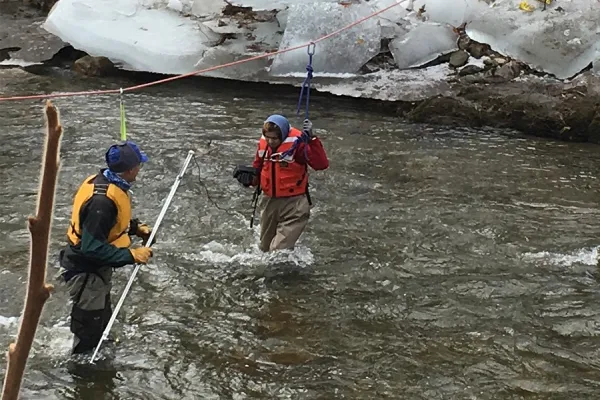Real World Riverbank Design
Research & Inquiry

Published May 14, 2018
A Mill River bank protection project she worked on for this year’s Engineering Design Clinic has changed the way Fereshta Noori ’18 thinks about about “doing engineering.”
“I learned that engineering design is not always a straightforward path,” Noori says. “Unexpected things happen, and you have to show flexibility.”
Noori and three fellow Smith seniors—Marcia Rojas, Laura Rosenbauer and Maya Sleiman—worked with the Mill River Greenway Initiative on a design aimed at improving riverbank safety at a dangerous river bend along Route 9 near Williamsburg that is part of a planned bike and walkway.
Talking to members of the “Greenway Guardians” team about their project is like interviewing the staff of a professional engineering firm. The conversation is studded with references to “roughness coefficients,” “stream barbs” and “live staking.”
The first step in designing a way to shore up the steep riverbank near the bend was to create a hydraulic model that could predict water flows around the bank. “Our goal was to find a design that doesn’t allow the water level to rise above the greenway bank and is able to withstand high water velocities,” says Rojas.
The final designs—which the team also presented at a public meeting of the Williamsburg Mill River Greenway Committee—address water velocities in three different zones near the river bend. In Zone One, the team proposed redirecting the flow with woody shrub cuttings (live staking) and low rock sills (stream barbs) on the bank. In Zones Two and Three, they recommended use of a traditional concrete wall and “riprap” rock armor along the bank.
Working with multiple stakeholders—including area homeowners and representatives of local and state regulatory agencies—was instructive, team members say.
“We had such a wide variety of clients, and there were different bioengineering strategies,” says Rosenbauer.
“We learned there are parts of a project that aren’t engineering at all,” adds Sleiman, “like letting the neighbors know you’re there to survey and making sure you’re effectively communicating about your project.”
The connections made by the team will be important to future Smith students who want to work with the greenway initiative, says Susannah Howe, a senior lecturer in engineering and longtime director of the Design Clinic.
“This is as good an example of students collaborating with multiple professional engineers as I’ve ever seen,” she says. “In these projects, our students are creating real-world designs with actual clients who care about the outcome.”
Brett Towler, a hydraulic engineer for the U.S. Fish and Wildlife Service and a technical adviser to the student project, says the work of the Smith team will provide real value to the greenway initiative, which seeks to connect communities along the Mill River.
“Their work will be incredibly useful to several phases of the design and permitting process,” Towler says. “It’s not just going on a shelf.”
Fereshta Noori ’18 surveying the Mill River with safety line help from Paul Wetzel, Smith lecturer in environmental science and policy.